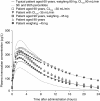Rivaroxaban and other novel oral anticoagulants: pharmacokinetics in healthy subjects, specific patient populations and relevance of coagulation monitoring
- PMID: 23809871
- PMCID: PMC3726366
- DOI: 10.1186/1477-9560-11-10
Rivaroxaban and other novel oral anticoagulants: pharmacokinetics in healthy subjects, specific patient populations and relevance of coagulation monitoring
Abstract
Unlike traditional anticoagulants, the more recently developed agents rivaroxaban, dabigatran and apixaban target specific factors in the coagulation cascade to attenuate thrombosis. Rivaroxaban and apixaban directly inhibit Factor Xa, whereas dabigatran directly inhibits thrombin. All three drugs exhibit predictable pharmacokinetic and pharmacodynamic characteristics that allow for fixed oral doses in a variety of settings. The population pharmacokinetics of rivaroxaban, and also dabigatran, have been evaluated in a series of models using patient data from phase II and III clinical studies. These models point towards a consistent pharmacokinetic and pharmacodynamic profile, even when extreme demographic factors are taken into account, meaning that doses rarely need to be adjusted. The exception is in certain patients with renal impairment, for whom pharmacokinetic modelling provided the rationale for reduced doses as part of some regimens. Although not routinely required, the ability to measure plasma concentrations of these agents could be advantageous in emergency situations, such as overdose. Specific pharmacokinetic and pharmacodynamic characteristics must be taken into account when selecting an appropriate assay for monitoring. The anti-Factor Xa chromogenic assays now available are likely to provide the most appropriate means of determining plasma concentrations of rivaroxaban and apixaban, and specific assays for dabigatran are in development.
Figures




Similar articles
-
Non-vitamin K antagonist oral anticoagulants in cardiovascular disease management: evidence and unanswered questions.J Clin Pharm Ther. 2014 Apr;39(2):118-35. doi: 10.1111/jcpt.12122. Epub 2014 Jan 3. J Clin Pharm Ther. 2014. PMID: 24383983 Review.
-
Comparative efficacy and safety of the novel oral anticoagulants dabigatran, rivaroxaban and apixaban in preclinical and clinical development.Thromb Haemost. 2010 Mar;103(3):572-85. doi: 10.1160/TH09-09-0659. Epub 2010 Feb 2. Thromb Haemost. 2010. PMID: 20135071 Review.
-
Limitations of Specific Coagulation Tests for Direct Oral Anticoagulants: A Critical Analysis.J Am Heart Assoc. 2018 Oct 2;7(19):e009807. doi: 10.1161/JAHA.118.009807. J Am Heart Assoc. 2018. PMID: 30371316 Free PMC article.
-
New oral anticoagulants: comparative pharmacology with vitamin K antagonists.Clin Pharmacokinet. 2013 Feb;52(2):69-82. doi: 10.1007/s40262-012-0030-9. Clin Pharmacokinet. 2013. PMID: 23292752 Review.
-
Bleeding with dabigatran, rivaroxaban, apixaban. No antidote, and little clinical experience.Prescrire Int. 2013 Jun;22(139):155-9. Prescrire Int. 2013. PMID: 23866358 Review.
Cited by
-
Time Course of the Interaction Between Oral Short-Term Ritonavir Therapy with Three Factor Xa Inhibitors and the Activity of CYP2D6, CYP2C19, and CYP3A4 in Healthy Volunteers.Clin Pharmacokinet. 2024 Apr;63(4):469-481. doi: 10.1007/s40262-024-01350-x. Epub 2024 Feb 23. Clin Pharmacokinet. 2024. PMID: 38393578 Free PMC article. Clinical Trial.
-
New oral anticoagulants: their advantages and disadvantages compared with vitamin K antagonists in the prevention and treatment of patients with thromboembolic events.Ther Clin Risk Manag. 2015 Jun 24;11:967-77. doi: 10.2147/TCRM.S84210. eCollection 2015. Ther Clin Risk Manag. 2015. PMID: 26150723 Free PMC article. Review.
-
Review Article: Gastrointestinal Bleeding Risk with Direct Oral Anticoagulants.Cardiovasc Drugs Ther. 2022 Oct;36(5):973-989. doi: 10.1007/s10557-021-07211-0. Epub 2021 Jun 18. Cardiovasc Drugs Ther. 2022. PMID: 34143317 Review.
-
Pulmonary embolism: new treatments for an old problem.Open Access Emerg Med. 2016 Oct 31;8:87-95. doi: 10.2147/OAEM.S103912. eCollection 2016. Open Access Emerg Med. 2016. PMID: 27843361 Free PMC article. Review.
-
Anticoagulation with warfarin and rivaroxaban ameliorates experimental autoimmune encephalomyelitis.J Neuroinflammation. 2017 Jul 28;14(1):152. doi: 10.1186/s12974-017-0926-2. J Neuroinflammation. 2017. PMID: 28754118 Free PMC article.
References
-
- Ageno W, Gallus AS, Wittkowsky A, Crowther M, Hylek EM, Palareti G. Oral anticoagulant therapy: antithrombotic therapy and prevention of thrombosis, 9th ed: American College of Chest Physicians evidence-based clinical practice guidelines. Chest. 2012;141:e44S–e88S. doi: 10.1378/chest.11-2292. - DOI - PMC - PubMed
-
- Bayer Pharma AG. Xarelto® (rivaroxaban) summary of product characteristics. 2013. http://www.ema.europa.eu/docs/en_GB/document_library/EPAR_-_Product_Info....
-
- Janssen Pharmaceuticals Inc. Xarelto® (rivaroxaban) prescribing information. 2013. http://www.accessdata.fda.gov/drugsatfda_docs/label/2013/022406s004lbl.pdf.
-
- Bristol-Myers S, Pfizer EEIG. Eliquis® (apixaban) summary of product characteristics. 2013. http://www.ema.europa.eu/docs/en_GB/document_library/EPAR_-_Product_Info....
LinkOut - more resources
Full Text Sources
Other Literature Sources

